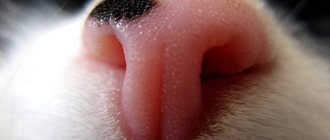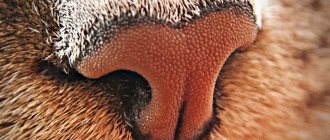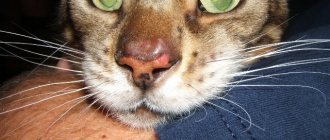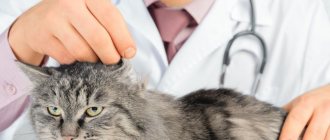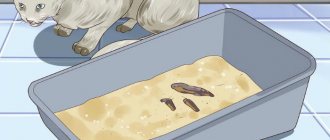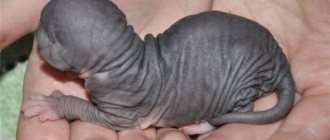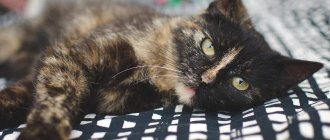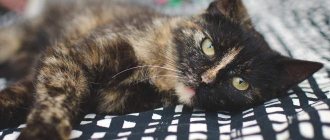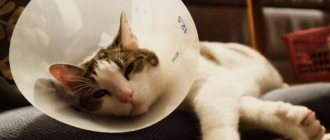Please tell me why recently my 6-month-old cat’s nose sometimes turns white, is it generally pink? Elena
A cat's nose
is a unique organ.
Its structure and shape are as individual as a person’s fingerprints. The nasal cavity is lined with a mucous membrane containing blood vessels and nerves. It is the first line of defense against foreign bodies and bacteria. Inside the nose there is an epithelium containing receptors. A cat's nostrils are located in bone and cartilage tissue. They are responsible for heating the air when you inhale and removing moisture from it when you exhale.
In addition, a cat’s nose is a delicate organ by which one can judge the state of its health and identify signs of disease.
All healthy cats' noses are normally cool and moist. It is moistened by both the secretion secreted by the nasal mucosa and by the tongue when licked. But you can’t judge a cat’s temperature by the moisture in its nose, since its nose is always dry and warm during sleep, in the heat and when excited. In older animals, the nose may constantly be dry and warm due to poor functioning of the gland that produces secretions to moisturize it.
How to treat rhinotracheitis in cats?
The treatment regimen depends on the severity of the disease. For mild rhinotracheitis, therapy is not required. It is enough to clean the animal’s nose and eyes from the resulting crusts using a cotton pad previously soaked in saline solution. If the cat’s appetite has worsened, the veterinarian will select a more nutritious and balanced diet. At this stage, it is extremely important to monitor the condition of the animal.
For severe rhinotracheitis, the veterinarian prescribes medications. They are selected individually, depending on the symptoms of the disease and the condition of the animal. The following drugs are usually prescribed:
- Antibiotics . They are recommended by a veterinarian if rhinotracheitis is accompanied by a secondary infectious disease or when concomitant infections occurring simultaneously with it are identified;
- Interferon-based products . For recurrent rhinotracheitis, such drugs are used locally - they need to be instilled several times a day into both eyes and nasal passages to prevent further development of the disease;
- Immunomodulators . They increase the animal’s body’s resistance to various diseases and strengthen cellular immunity. Additionally, immunomodulators produce antibodies against the pathogen;
- Sulfonamide drugs . They are synthetic antimicrobial agents prescribed to prevent the growth of bacteria and chlamydia. Such drugs have chemotherapeutic activity against a number of infections;
- Vitamin and mineral complexes . They are intended to restore the animal’s body and prevent the development of secondary infections. After the examination, the veterinarian will recommend which vitamin and mineral complexes are best for your pet.
In order for your cat to quickly cope with rhinotracheitis, follow all the veterinarian’s recommendations and do not self-medicate - do not risk the health of your beloved pet!
Infection with calcivirus
A cat with calcivirus can infect its relatives through saliva. The virus is also found in discharge from the animal's eyes and nose. Since one of the signs of the disease is sneezing, the virus can get to a healthy cat, which will be at a distance of several meters from the sick animal.
In addition, the calcivirosis virus is found in the feces and urine of an infected animal.
In hot, dry weather, the virus lives in the environment for 7 days. In damp and cold seasons, the virus lives longer.
Thus, healthy cats can become infected with calcivirus not only from a sick animal, but also through environmental objects. A person can also be a carrier of the virus. Kittens suffer from the disease more severely than adults.
The following categories of cats are more susceptible to infection with calcivirus:
- animals that have weak immunity to infectious diseases;
- cats that have not been vaccinated against calcivirus;
- cats with chronic diseases;
- kittens.
What kind of nose should a healthy cat have?
A cat’s nose is a rather complex organ, which is designed for smell and detailed study of the surrounding world. Thanks to their sense of smell, cats can detect subtle odors that signal them of approaching danger, threat or prey. Also, cats can miraculously sense the scent of their owner even over long distances.
The intricate structure of the nose allows the cat to have visual defects and this will not at all interfere with her living a normal and fulfilling life. It will help her easily navigate space and independently move around rooms, looking for food and a litter tray.
Rhinitis is inflammation of the nasal mucosa.
The main risk factors for the development of AR are: 1. Family history - hereditary factors, allergic diseases in the family. 2. Allergic sensitization. Year-round AR is characterized by exposure to allergens characteristic of enclosed spaces (household allergens, house dust mite allergens, fungal allergens, pet allergens) 3. Contributing factors (smoking, quality of inhaled air in the home, air pollution, climatic factors). 4. “Lifestyle” factors. 5. Relatively high socio-economic status.
Distinguishes the following main stages of AR: 1. Vasotonic stage
.
It is characterized by a constant change in vascular tone and is clinically manifested by variable nasal congestion. 2. Stage of vasodilation.
Nasal congestion is constant due to dilation of the mucous vessels.
3. Stage of chronic edema.
The nasal mucosa changes from pale marble to bluish, and nasal congestion is almost constant.
4. Stage of hyperplasia.
The nasal mucosa grows, polyps form, the paranasal sinuses are often involved in the process, secondary otitis develops, and a secondary infection is almost always associated.
These stages of development of a single pathological process are realized due to markers of inflammation in the territory of the nasal mucosa.
Biological markers of inflammation in allergic rhinitis
1. Cytokines: - Monokines (GM-CSF, TNF, IL1, IL5, IL6, IL8, IL12, IL15) - Lymphokines (IL2, IL4, IL13, gamma-IFN) 2. Leukotrienes: - Cysteine (LTC4, LTD4, LTE4 ) - Non-cysteine (LTB4) 3. Granular proteins: - Eosinophil (cationic protein, peroxidase, protein X, neurotoxin) - Mast cell tryptase 4. Adhesion molecules: - Endothelial adhesion molecule - ELAM-1 - Vascular adhesion molecule - VCAM-1 - Intercellular adhesion molecule - ICAM-1
Clinical forms of allergic rhinitis:
The definition of
“mild”
means that the patient has only minor clinical signs of the disease that do not interfere with daytime activities and/or sleep.
The patient is aware of the presence of manifestations of the disease and may be ready to be treated, but here everything depends on his personal desire. The definition of “moderate”
means that the symptoms disturb the patient’s sleep, interfere with work, study, and sports.
The quality of life deteriorates significantly. The term "severe"
means that the symptoms are so severe that the patient is unable to work, study, play sports or leisure activities during the day, or sleep at night unless treated.
The term “episodic (or intermittent)”
means that the manifestations of AR bother the patient less than 4 days a week or less than 4 weeks a year.
The term “frequent (persistent) presence of symptoms”
means that the patient reports symptoms of the disease more than 4 days a week or more than 4 weeks a year.
Perennial allergic rhinitis (PAR) (persistent)
caused by the following allergens:
- House Dust Mites
House dust mites are microscopic arachnids (Arachnids) found in indoor dust, especially in bedrooms, upholstered furniture, carpets, curtains, etc. The sizes of the most common species, Dermatophagoides pteronyssinus and Dermatophagoides farinae, do not exceed 0.4 mm. At all stages of their development, these mites are keratinophages, i.e. they feed on desquamated epidermis (dead flakes of the upper layers of human or animal skin, which sometimes make up up to half the volume of house dust). Under conditions of optimal humidity (relative humidity 70-80%) and temperature (20-300C), the life cycle of ticks is approximately one month and includes the following stages: egg, larva, protonymph, tritonymph and adult. During her life, a female tick lays 70-100 eggs. o Under favorable living conditions, the mite population can grow very quickly, and tens of thousands of individuals can be found in 1 g of dust.
- Microscopic fungi are distributed almost everywhere. Fungal spores were found even at an altitude of more than 2000 m. The concentration of fungal spores in the air, even during the period of intense flowering of plants, is a thousand times (1000!) higher than the concentration of pollen grains. Molds consist of a system of small threads - mycelium - and reproduce by spores. The spores are small enough to enter the lower respiratory tract and even reach the alveoli. Yeasts are single-celled fungi that do not form filaments. In reality, a person comes into contact with 100 species of mushrooms. The species composition of mushrooms differs indoors and outdoors. In the air of cities in warm weather there is an average of 3100 spores/m3 of air. In the open air, Cladosporium and Alternaria predominate, in smaller quantities - Penicillium and others. These fungi are characterized by great seasonal variability with a maximum in summer and a minimum in winter. But, since the concentration of their spores is increased throughout the warm period, the flowering and spore formation calendar does not help diagnose allergies. In house dust and indoor air, the fungi Aspergillus and Penicillium are more often released, in smaller quantities - Cladosporium, Alternaria, Mucor, Candida, etc. Aspergillus and Penicillium reproduce all year round. Indoors, higher levels are observed in autumn and winter. They are called storage fungi and cause rotting of stored grains, fruits and vegetables. Penicillium can often be seen on items stored in basements as patches of green mold. There are no clear standards for the content of fungi in the air, only a conditional standard - no more than 500 spores/m3, but during research it turned out that in more than 80% of rooms it was exceeded, and in some the concentration of spores in the air reached tens and hundreds of thousands per m3. For Cladosporium and Alternaria, the content norm is 102 and 3 x 103/m3. The highest concentrations of fungi were found in old houses, on the first floors of buildings and in rooms with various leaks. Mold loves damp and warm places, bathroom walls, shower stalls, trash cans, refrigerators. The source of mold can be moldy products, old paper wallpaper, linoleum. Fungi can colonize household appliances such as humidifiers or air conditioners. Flower pots are often the source of Cladosporium and Alternaria, which live on rotting parts of plants, but the connection between indoor flowers and the number of fungi is not as great as thought. Yeasts can also live in the soil.
- In the dwellings of central Russia, there are mainly three species of cockroaches, the allergens of which are the cause of the development of allergic diseases in humans: Blatta orientalis, Blattella germanica and Periplaneta Americana. The high antigenic activity of insect body particles is mainly associated with anthropodin (a water-soluble protein that makes up 15% to 50% of the cuticle). Sensitization to cockroaches can develop through bites, direct contact with insect bodies and cockroach metabolites. House dust from infected apartments contains cockroach allergens: saliva, feces, insect body tissue. The most pronounced allergenic properties are found in fragments of the head, cuticles and excrement.
- The main allergen in cats is Fel d1 (1-10 µm, average 3.5 µm). The main source of Fel d1 is animal saliva; it is also found in the sebaceous glands of the skin. In cats, but not in cats, Fel d1 is also excreted in urine. In general, cats produce significantly more allergens than cats. After removing the cat from the premises and/or carrying out elimination measures against the cat allergen, a decrease in the level of allergens and the symptoms they cause is usually observed no earlier than 6 months. Because Fel d1 is very resistant to the environment. Do you like to visit prostitutes? And even at an age? There are mature prostitutes from Tyumen here: https://sex-tumen.prostitutki72.com/zrelye Intimacy for the evening is guaranteed. Dog allergens are found in animal dander, saliva, urine and serum. The main dog allergen is Can f1. Different breeds of dogs emit allergens that vary in spectrum and quantity.
| Profession | Allergen |
| Baker | Flour |
| Laboratory worker | Laboratory animals |
| Painter painting with spray gun | Isocyanates |
| Workers exposed to plastics and resins | Anhydrides |
| Carpenter | Western Red Cedar Wood |
| Medical workers | Latex |
Food products as etiological factors of food allergies, according to the degree of allergenic activity (without taking into account individual characteristics)
| Activity level | Products |
| High | Cow's milk, fish, crustaceans, eggs, chicken meat, strawberries, raspberries, wild strawberries, blackcurrants, blackberries, grapes, pineapples, melons, persimmons, pomegranates, citrus fruits, chocolate, coffee, cocoa, nuts, honey, mushrooms, mustard, tomatoes , carrots, beets, celery, wheat, rye |
| Average | Pork, turkey, rabbit, potatoes, peas, peaches, apricots, red currants, bananas, green peppers, corn, buckwheat, cranberries, rice |
| Weak | Horse meat, lamb (low-fat varieties), zucchini, squash, turnips, pumpkin (light colors), green and yellow apples, white currants, gooseberries, plums, watermelon, almonds, green cucumbers |
In addition to antigens, clinical manifestations of AR
can be provoked by such trigger factors as infection, nonspecific irritants, tobacco smoke, pollutants, cold air, drafts, which indicates the formation of nonspecific hyperreactivity of the nasal mucosa.
Diagnostic measures for CAP:
1. Taking an anamnesis. 2. General blood test. 3. Examination by an allergist-immunologist, ENT doctor. 4. Skin testing with a set of mixed allergens followed by additional examination with the corresponding group of allergens. Determination of total serum IgE and specific IgE to specific allergens. 5. Conducting provocative nasal tests 6. Cytological examination of a smear-imprint from the nasal mucosa, washings for bacteriological examination. 7. Determination of the function of the ciliated epithelium of the nasal mucosa. 8. X-ray examination of the nose and/or paranasal sinuses.
Preventive and therapeutic measures for CAP:
1. Elimination of causally significant allergens.
(detailed information is presented 2. SIT 3. Antihistamine therapy, taking into account the need for long-term use of antihistamines (it is advisable to prescribe 3rd generation drugs, since they have minimal side effects and can be used for a long time) 4. Prescription of cromones (for example, cromohexal in the form of a nasal spray, practically has no side effects) . Immunology and allergology. Algorithms for diagnosis and treatment. - M.: Geotar-Med, 2003. 2. Pukhlik B. M. Elementary allergology. - Vinnitsa, 2002. 3. Gushchin I.S., Ilyina N.I., Polner S.A. Allergic rhinitis. - M., 2002. 4. Stanley M. Nagua, M. Eric Gershwin. Secrets of allergology and immunology. M.: Binom, 2004. 5. Khaitov R.M. Clinical allergology. - M.: "MEDpress-inform", 2002. 6. Roy Patterson, Leslie K. Gremmer. Allergic diseases. - M., Geotar Medicine., 2000.
Diagnosis and treatment
If a cat has a white or bluish nose, then there is a suspicion of anemia or cardiac pathology. A red nose may indicate injury. To identify the cause, the veterinarian listens to complaints, conducts an external examination and prescribes diagnostic procedures, depending on the preliminary diagnosis, such as:
- radiography;
- ECG;
- blood chemistry;
- scraping scales from the skin to test for fungus;
- analysis of ear discharge to detect ticks;
- polymerase chain reaction to detect herpes virus.
Cat noses are treated depending on the disease. Rhinotracheitis is incurable, but an acute attack can be treated with antibiotics or antiviral drugs, which are individually prescribed by a veterinarian. For injuries, rhinoplasty is performed or anti-inflammatory drugs are used. Special drops are prescribed against fungus or ear mites. With necrosis, dead particles are eliminated.
Why the nose has changed: dangerous signs
After receiving a bruise, your pet's olfactory organ may swell.
If a cat’s nose is white or acquires a different color, alarming signs appear, this indicates the following pathological conditions:
- Injury. Occurs in a street cat or a domestic cat visiting the street when a blow to the face occurs. The nose becomes purple or blue due to a hematoma, has greatly increased in size, is swollen, the cat has difficulty breathing, and there is not intense bleeding or crusting. The nose is hot due to bruise. If it turns red, it may be a wound or scratch.
- Fungus. A yellow coating on the nose may indicate candidiasis. Symptoms of the disease also appear on the mucous membranes of the mouth. The affected area smells unpleasant, there is itching, redness and peeling of the skin in the bridge of the nose and other areas. The temperature of the nose may remain within normal limits, and there is no humidity due to damage to the mucous membrane. Often the fungus spreads to the paws, neck or abdomen.
- Ear mite. If the cat is more likely to have otodectosis, discharge from the ears spreads across the face and sticks to the top of the nose. It seems that the cat has a dirty nose. However, when a cat constantly scratches its ears, an unpleasant odor appears, and a brown coating forms near the natural bald spots on the head - this is a reason to start treatment. The nose may be warm due to irritation from an animal that is sick.
- Necrosis. When the nose darkens or turns black, becomes wet, and begins to change shape, this indicates tissue death. Depending on the type of necrosis, the cat's nose is very wet, because it is rotting, or dry, covered with a dense crust.
Infectious diseases
With developing rhinotracheitis, the fluffy suffers from a runny nose and dried crusts on the mirror.
If your pet sneezes, coughs, hides in a dark place, refuses food and water, and does not play, this means that she is sick. The temperature in cats with infectious diseases rises, the nose becomes dry and hot. When the disease is accompanied by a runny nose, it is damp due to copious mucous discharge, which forms dry crusts and prevents the pet from breathing. The condition requires immediate veterinary attention, since this is how rhinotracheitis or feline herpes manifests itself - a dangerous disease for cats.
